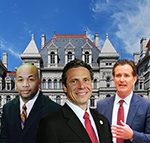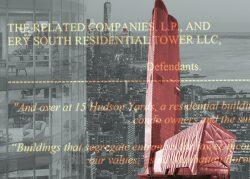The edifice rises suddenly, its sheer brick masonry cut with floor-to-ceiling windows — a stunning contrast to the low-rise pizza and chicken shack next door.
In a gentrifying neighborhood like Bedford-Stuyvesant, projects like this seem inevitable: a handsome, mid-sized apartment building for young, white-collar transplants, with eight of the 26 units income-restricted and within reach of local residents.
But nothing about 1425 Fulton Street was inevitable. Merely getting the project to pencil out took developer Arthur Wiener more than a decade.
It required a funding arrangement only available to established builders like Wiener, who could afford to wait for years as the property value increased. It needed a peculiar lot merger that added thousands of square feet of air rights. Also essential was access to the city’s largest tax expenditure program, one whose very existence hangs in the balance as new administrations form in Albany and City Hall.
And after all that work, just eight affordable units.
Wiener, the owner of United Management Corporation, has been building across New York for decades. His portfolio tends toward market-rate high-rises in Manhattan and Brooklyn.
Discussing the Bed-Stuy project’s impact on the neighborhood, Wiener thinks back to his parents, who arrived in the country speaking no English. “Only in America would I be able to give back what this country has given me,” said Wiener.
To be sure, he expects to make money on 1425 Fulton. Indeed, it is a case study in whether market forces, with a boost from programs such as Mandatory Inclusionary Housing and the 421a tax abatement, can produce below-market rents.
No vacancy
New York’s housing shortage is no secret. But the problem seems like quicksand — the more effort is thrown at it, the deeper the crisis gets.
Yet Matthew Murphy is optimistic.
The executive director of the NYU Furman Center and a former policy wonk at the Department of Housing Preservation and Development, Murphy doesn’t just study the quicksand. He’s neck-deep in it. Murphy led the division that devised Mandatory Inclusionary Housing and reformed 421a, making him a chief engineer of the fraying, resilient ropes the city is counting on to pull its housing market from the muck.
The most recent Housing and Vacancy Survey, from 2017, found just 3.6 of every 100 rentable apartments in the city were empty. In a looser market with more available units, rents would dip as owners competed for tenants. But with 3.6 percent vacancy, landlords have the leverage. And that rate includes uber-luxe units out of reach to most buyers. For lower-earning home hunters, the situation was even more dire.
“We have an extreme shortage — almost none, no available housing — for low-cost apartments,” said Murphy. For units under $800 a month, the vacancy rate was just 1 percent.
New census data show a less severe shortage, particularly in Manhattan, but Murphy cautions that it could be temporarily inflated by pandemic relocations and other fleeting factors.
In recent years, the city has relied on large, publicly financed buildings for the bulk of its low-rent housing. “The top dog for affordable housing is still city-subsidized with city capital. No matter what program you call it, that’s really the money that’s coming through,” said Murphy.
Regardless of how a project gets funded, or how many affordable units it offers to create, it must overcome one burden just the same as every other construction project in New York: permits.
“The actual construction side is not what’s driving these long timelines,” said Murphy. “You’re talking about most of the time just being spent on getting approvals,” he said.
Read more


Once projects emerge from this bureaucratic purgatory, they tend to come together quickly. A Furman Center analysis found that the median new construction project took just under two years to build after receiving its permit. Though some construction timelines stretched as long as 10 years, those were anomalies. The vast majority spent no longer than four years between approval and receiving a temporary certificate of occupancy.
In the end, there are limits to what the government can spend on large, deeply affordable developments. “There are way more projects that people want to do than there is funding available,” said Murphy. “There is a long list, a huge pipeline of projects that need subsidy in order to get built.”
His conclusion: “The government is not going to be able to do this on its own.”
Playing the game
Carmi Bee remembers a time when even middle-income apartments had a foyer.
“Nowadays, planning of apartments is done formulaically,” said the architect, who has worked at RKTB since interning there in 1965. Discussing the inspirations behind his design work for 1425 Fulton, Bee zips through time and across neighborhoods, his mental reference points reaching from the foyers of Emery Roth’s prewar high-rises down to Stuytown, with its windowed bathrooms and kitchens. They weren’t always luxurious, but they represented an attainable dignity for middle-income New Yorkers.
“Those standards in those days, that was expected,” he said. But now, “the quality of the living space is not what it used to be.”
Bee has spent a lifetime in architecture, poring over details a tenant might never even notice. He obsesses over lot-line walls. But in designing 1425 Fulton, a building with both market-rate and affordable units, he had to perform a high-wire walk between cost and quality.
It involves a thousand little choices, between materials and fixtures and rooftop amenities. They may sound trivial, but they can determine whether a project is financially viable.
“You can’t be a residential architect in New York If you don’t know how to play the game,” said Bee.
The game is more than a choice between concrete and steel. It also requires developers and their teams to navigate the city’s maze of building restrictions. And a perfect rectangle of empty land is hard to find.
“Every developer wants to get a site, and the ones that are available always present a problem,” said Bee.
At 1425 Fulton, for example, there wasn’t enough land for what Wiener needed to build to make a profit.
A month after he bought the lot in 2007, the City Council approved a rezoning of southern Bed-Stuy, bumping his lot’s floor-area ratio, or FAR, up to 4.2. But he still could not build enough units to overcome the expense of setting below-market rents for at least a quarter of the development, as the 421a tax abatement required.
Wiener needed to build taller than the lot allowed. So he bought some air.
One of the most popular ways to expand a project is to acquire air rights. If the building on an adjacent plot is smaller than its zoning allows, the owner can sell its unbuilt square footage to its neighbor. The savior of 1425 Fulton was First African Methodist Episcopal Zion Church, which bordered a bit of the lot’s interior corner.
Built in 1910, the church occupies a 27,000-square-foot lot, more than five times the size of Wiener’s. Although the First AME Zion’s brick steeple looms tall above MacDonough Street, the church itself is massively underbuilt.
In September 2018, United and RKTB paid the church nearly $300,000 for 4,166 square feet of development rights — much cheaper than buying a lot outright.
But the biggest impediment to the project, by far, was running the gauntlet of the city bureaucracy — an alphabet soup of three-letter agencies with attendant deadlines and endless forms. Their rent assistance and tax break programs make projects like 1425 Fulton possible, but also stretch their timelines to chasmic lengths.
“You can get swamped with just the paperwork,” said Jeffry Wengroff, principal at program management firm HE2PD. “It literally takes months with these programs.”
An owner’s representative, Wengroff describes himself as a “developer for hire.” Developers like Wiener bring him the cocktail-napkin sketch of the building. He handles the rest.
Wengroff says he ran hundreds of models to determine which combination of city programs would yield the best returns based on the lot and air rights Wiener’s team cobbled together. Should they add senior housing in return for increased FAR and decreased parking requirements? Go full market-rate and shoulder the taxes that come with it?
They settled on the 421a tax break, which wipes out the project’s property taxes for up to three years of construction and 25 years after completion, then tacks on 10 more years of discounts. The city’s largest tax expenditure, 421a reduces its yearly haul by more than $1.7 billion — 10 times the entire annual budget of the Department of Buildings.
Developers have a few ways to qualify for the break. Wiener opted to set aside 30 percent of his units for renters earning up to 130 percent of the area median income, as opposed to including fewer affordable units but at even lower rents. “That comes out to almost 90 percent of market-rate,” Wengroff said of the option they chose.
The program expires in June 2022, and will almost certainly be reconfigured by state lawmakers — if they renew it at all. That portends another headache for builders, as in 2016, when the program lapsed for more than a year. Wengroff will have to tweak his modeling software.
But at least Wiener did not have to deal with Mandatory Inclusionary Housing, which requires affordable units in projects that benefit from rezoning, because the Bed-Stuy rezoning came before the law passed.
Showtime
Fourteen years after conception, 1425 Fulton is almost ready to hit the market. All it needs is one more permit — the coveted temporary certificate of occupancy, or TCO.
Wiener beams when he describes the final product his team assembled. “They really made a subsidized housing project into something more than that,” he said.
But he’s clear-eyed about how they got here.
“I combine my economic interest with the community interest,” he said. “If they wouldn’t have given me the tax benefits, I wouldn’t have put affordable housing in.”
